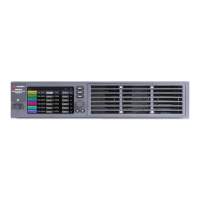OUTPut is the root keyword, INhibit is a second-level keyword, CLEar is a third-level keywords. Colons
( : ) separate the keyword levels.
The command syntax shows most commands (and some parameters) as amixture of upper- and
lower-case letters. The upper-case letters indicate the abbreviated spelling for the command. For
shorter program lines, you can send the abbreviated form. For better program readability, you can
send the long form.
In the above examples, OUTP and OUTPUT are both acceptable forms. You can use upper- or lower-
case letters. Therefore, OUTPUT, outp, and Outp are all acceptable. Other forms such as OUT, are not
valid and will generate an error.
Queries
Following a keyword with a question mark (?) turns it into a query (Example: VOLTage?, CURRent?). If
a query contains parameters, place the query indicator at the end of the last keyword, before the
parameters. Insert a space between the query indicator and the first parameter.
You can query the programmed value of most parameters. For example, you can query the voltage
setting by sending:
VOLTage?
You can also query the minimum or maximum allowable voltage settings as follows:
VOLTage? MIN, (@<chanlist>)
VOLTage? MAX, (@<chanlist>)
You must read back all the results of a query before sending another command to the instrument.
Otherwise, a Query Interrupted error will occur and the unreturned data will be lost.
Command Separators and Terminators
Separators
Colons ( : ) separate keyword levels. Blank spaces must be used to separate command parameters
from their corresponding keyword. If a command requires more than one parameter, use a comma to
separate adjacent parameters. In the following example, the <current>{,<current} values must be
separated with a comma.
MEMory:TABle:CURRent[:MAGNitude] <current>{,<current>}
Semicolons ( ; ) separate commands and can be used to separate commands within the same
subsystem. This lets you send several subsystem commands within the same message string. For
example, sending the following command string:
OUTPut:STATe ON, (@<chanlist>);PROTection:CLEar (@<chanlist>);COUPle ON
is the same as sending the following commands:
5 SCPI Programming Reference
98 Keysight MP4300 Series Operating and Service Guide

